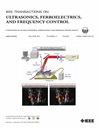Deep Power-Aware Tunable Weighting for Ultrasound Microvascular Imaging
IF 3
2区 工程技术
Q1 ACOUSTICS
IEEE transactions on ultrasonics, ferroelectrics, and frequency control
Pub Date : 2024-10-31
DOI:10.1109/TUFFC.2024.3488729
引用次数: 0
Abstract
Ultrasound microvascular imaging (UMI), including ultrafast power Doppler imaging (uPDI) and ultrasound localization microscopy (ULM), obtains blood flow information through plane wave (PW) transmissions at high frame rates. However, low signal-to-noise ratio (SNR) of PWs causes low image quality. Adaptive beamformers have been proposed to suppress noise energy to achieve higher image quality accompanied by increasing computational complexity. Deep learning (DL) leverages powerful hardware capabilities to enable rapid implementation of noise suppression at the cost of flexibility. To enhance the applicability of DL-based methods, in this work, we propose a deep power-aware tunable (DPT) weighting (i.e., postfilter) for delay-and-sum (DAS) beamforming to improve UMI by enhancing PW images. The model, called Yformer, is a hybrid structure combining convolution and Transformer. With the DAS beamformed and compounded envelope image as input, Yformer can estimate both noise power and signal power. Furthermore, we utilize the obtained powers to compute pixel-wise weights by introducing a tunable noise control factor (NCF), which is tailored for improving the quality of different UMI applications. In vivo experiments on the rat brain demonstrate that Yformer can accurately estimate the powers of noise and signal with the structural similarity index measure (SSIM) higher than 0.95. The performance of the DPT weighting is comparable to that of superior adaptive beamformer in uPDI with low computational cost. The DPT weighting was then applied to four different datasets of ULM, including public simulation, public rat brain, private rat brain, and private rat liver datasets, showing excellent generalizability using the model trained by the private rat brain dataset only. In particular, our method indirectly improves the resolution of liver ULM from 25.24 to用于超声微血管成像的深度功率感知可调加权法
超声微血管成像(UMI),包括超快功率多普勒成像(uPDI)和超声定位显微成像(ULM),通过高帧率的平面波传输获取血流信息。然而,平面波信噪比低,导致图像质量不高。人们提出了自适应波束成形器来抑制噪声能量,以获得更高的图像质量,但同时也增加了计算复杂度。深度学习(DL)利用强大的硬件能力,以灵活性为代价,快速实现噪声抑制。为了提高基于深度学习的方法的适用性,在这项工作中,我们提出了一种深度功率感知可调(DPT)加权(即后滤波器),用于延迟和(DAS)波束成形,通过增强平面波图像来改善 UMI。该模型被称为 Yformer,是一种结合了卷积和变换器的混合结构。以 DAS 波束成形和复合包络图像为输入,Yformer 可以估计噪声功率和信号功率。此外,我们还利用所获得的功率,通过引入可调噪声控制因子来计算像素权重,从而提高不同 UMI 应用的质量。大鼠大脑的活体实验证明,Yformer 可以准确估计噪声和信号的功率,其结构相似性指数(SSIM)高于 0.95。DPT 加权的性能可与 uPDI 中出色的自适应波束成形器相媲美,且计算成本较低。然后,将 DPT 加权法应用于四个不同的 ULM 数据集,包括公共模拟、公共大鼠大脑、私人大鼠大脑和私人大鼠肝脏数据集。特别是,我们的方法通过突出显示小血管,间接提高了肝脏 ULM 的分辨率,从 25.24 μm 降至 18.77 μm。此外,DPT 加权能以更快的处理速度显示出更多的血管细节,这有可能促进高质量 UMI 的临床应用。
本文章由计算机程序翻译,如有差异,请以英文原文为准。
求助全文
约1分钟内获得全文
求助全文
来源期刊
CiteScore
7.70
自引率
16.70%
发文量
583
审稿时长
4.5 months
期刊介绍:
IEEE Transactions on Ultrasonics, Ferroelectrics and Frequency Control includes the theory, technology, materials, and applications relating to: (1) the generation, transmission, and detection of ultrasonic waves and related phenomena; (2) medical ultrasound, including hyperthermia, bioeffects, tissue characterization and imaging; (3) ferroelectric, piezoelectric, and piezomagnetic materials, including crystals, polycrystalline solids, films, polymers, and composites; (4) frequency control, timing and time distribution, including crystal oscillators and other means of classical frequency control, and atomic, molecular and laser frequency control standards. Areas of interest range from fundamental studies to the design and/or applications of devices and systems.

 求助内容:
求助内容: 应助结果提醒方式:
应助结果提醒方式:


